Richard Trevithick was born in 1771 in England. He wasn't a good student. One of his teachers wrote that he was "disobedient, obstinate and slow."1
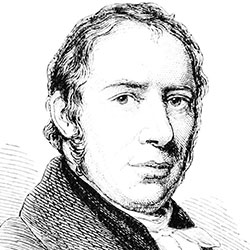
But he was fascinated with machines. Eventually, he built a machine that helped change the world.
By 1800, horses had pulled carts on tracks for nearly two hundred years. Moving the wheels on tracks cut down on friction. The horses could pull more on tracks than they could pull on a dirt road.
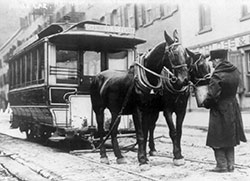
But no one had ever moved the carts with an engine instead of horses.
Richard Trevithick thought he could. He put a steam engine on wheels on tracks at the PenyDarren Ironworks, and made a locomotive. In 1804, his boss at PenyDarren bet a thousand guineas that the locomotive could haul ten tons of iron along a tram road.
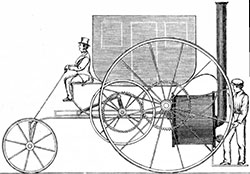
People came from far away to see the race. The bet was won, and Richard Trevithick became famous.2
After that, more inventors used steam engines to make things move. An American put a steam engine in a ship in 1807, and started carrying passengers on the Hudson river from New York to Albany.3 In 1825, the English opened a rail line to haul coal from the Darlington coal mines.
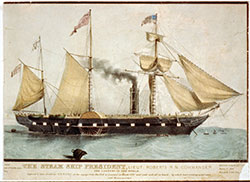
The Stockton-Darlington line was the first commercial rail line in the world.4 The French built a line in 1830; the Germans, in 1835.
Railroads and steamships changed the way people lived. People could buy fresh milk and vegetables that the trains transported from faraway places. They could visit faraway places, too, or live in the country and "commute" into the city by train. Steamships made it possible for millions of people to come to the United States from Europe.
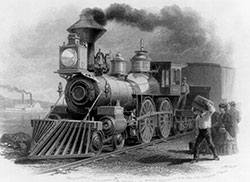
In the 1860s, two railroad companies built a line across the country. Now Americans could ride from New York to California, all by train!
Trains changed the way that people traveled in cities, too.
Some American cities were very crowded. New immigrants were coming to America for jobs and a better life. So many people came to New York City that from 1800 to 1880 the population there doubled every ten years!5
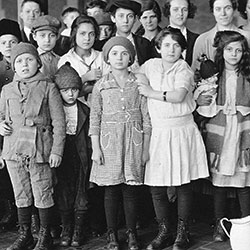
Newcomers moved into dark, ugly tenements and jammed the roads. Sometimes Broadway in New York City was so crowded with horses, omnibuses, horse cars, carriages and people that it could take twenty minutes just to cross the street!6
Horses were very important for transportation in cities then. But they made a terrible mess. Horse poop got everywhere! The poop mixed with the mud on rainy days, and dried out and blew into the air as dust on hot days. Flies gathered around it, and helped spread disease.7
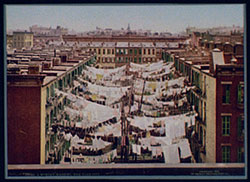
An inventor named Alfred Ely Beach wanted to built a subway in New York City, to make travel there easier. The government wouldn't let him, so he built it in secret! His workers started in the rented basement of a clothing store. They tunneled four hundred feet in two months.
The little subway opened in 1870. It was a big success, but the government wouldn't let Beach make it any bigger.8

In Richmond, Virginia, an inventor named Frank Sprague used electricity instead of horses to make streetcars move. His system opened in 1888. People came from all over the country to ride the Richmond streetcars and to see if they would work in their own towns.9
Cities around the world built electric rail systems. Subways opened in London, Paris, Madrid. New York City built a subway that became one of the largest in the world.

In Los Angeles, Henry Huntington built an over ground train system like the system in Richmond. In the mid 1920s, you could ride a Red Car from Los Angeles to Chatsworth, from Santa Monica to Redondo Beach, from Santa Ana to Artesia, even as far east as San Bernardino. Over 2,700 trains operated on 1,000 miles of track every day. It was the biggest interurban electric rail system in the entire world!10
But even as new trains were built and new train lines opened, another form of transportation was becoming popular. It hadn't existed when Alfred Beach dug his secret subway tunnel in New York.
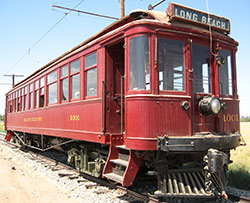
Now it was getting better and cheaper every year, and would change the way people traveled all over again.
The invention was the car.
Next : Chapter Two Quiz
Or : Return to Cover
1 Penydarren Locomotive,
2 ibid
3 The History of Steamboats
4 Stockton and Darlington Railway
5 Tenements
6 William D. Middleton, Metropolitan Railways, (Indiana University Press, 2003), pg. 2
7 Edwin Black, Internal Combustion, (St. Martins Press, 2006), pg. 37
8 Middleton, pg. 8
9 Brian J. Cudahy, Cash, Tokens and Transfers, (Fordham University Press, 2002), pgs. 35 - 45
10 The History of the Red Car
 |